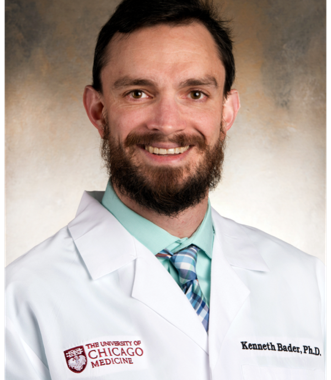Physics Alumni Success Stories
Dr. Kenneth B. Bader (2005)

While some find their eventual careers relate in an obtuse way to their undergraduate research experiences, my work has never strayed very far from the research I did within the Physics Department at Grand Valley State University. In the summer of 2004, I obtained funding through the Michigan Space Grant Consortium to study the impact acoustic cavitation on bone fractures. Under the guidance of Dr. Karen Gipson, I learned that acoustic cavitation was the action of bubble oscillations on the surrounding medium. I found sufficient interest in the topic to pursue graduate degrees in physics at the University of Mississippi. These studies revolved around a project intending to generate a thermonuclear reaction within a bubble undergoing an inertially-driven collapse. There was some precedent for the potential to generate a fusion reaction, as light emissions generated via thermal Bremsstrahlung as the bubble contents form a warm, dense plasma during the final stage of collapse. My work elucidated the influence of the static over-pressure on the strength of the bubble collapse in a resonant system. These results uncovered that the bubble collapse strength, indicated by light emissions and shock emission amplitude, were dependent on the energy stored in the system. That is, there was conservation of energy, a premise that should be of surprise to no physics student.
After my graduate studies, I was a postdoctoral fellow at the University of Cincinnati under the tutelage of Dr. Christy Holland. Our translation studies were centered on inducing sustained, subharmoic bubble activity to enhance the efficacy of fibrinolytic stroke treatment. Stroke is the fourth highest cause of death in the United States, and only 1.5% of patients receive thrombolytic drugs due to strict exclusion criteria. The use of oscillating bubbles as micropumps increases thrombolytic efficacy, thereby increasing the pool of patients that can receive therapy. While in Cincinnati, I also become interested in histotripsy, a form of therapeutic ultrasound that liquefies tissue at depth via rapid bubble expansion. Histotripsy can be utilized as a transcutaneous scalpel, lysing cells and breaking up the extracellular matrix without the need for an invasive surgical procedure.
I have continued the theme of cavitation in my research as an Assistant Professor in the Department of Radiology at the University of Chicago. My laboratory, the Biomedical Acoustics Development and Engineering Research Laboratory (or BADER Lab), is focused on the development of multimodal image guidance methods for histotripsy. By combining diagnostic ultrasound imaging to assess cavitation activity with MR imaging to detect changes in tissue structure, we hope to develop next generation therapies to treat chronic deep vein thrombosis and localized prostate cancer.
Cavitation has been THE central theme of my scientific and professional career, a topic that I would not have pursued without the support and guidance of the Physics Department at Grand Valley State University. Beyond cavitation, my time at Grand Valley taught me the importance of finding ways to solve problems. I learned physics is a great guise through which to learn problem solving, the critical skill necessary for long-term success regardless of one’s career path.
Share this spotlight
Return to the listing of physics alumni success stories.

